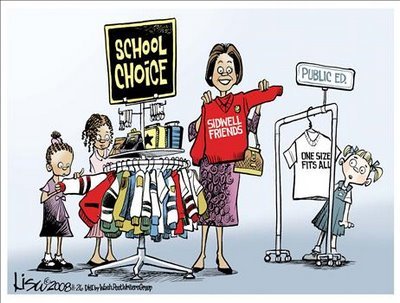Co-authored by Lennie Jarratt & Timothy Benson
The Network for Public Education (NPE), an anti-educational choice organization, released a new publication titled “Valuing Public Education: A 50 State Report Card,” which, distressingly, many media outlets are reporting as an honest-to-goodness objective study, instead of the piece of subjective advocacy it truly is.
NPE’s report card is essentially a rating system that attempts to show how well each state is protecting public schools controlled by the state — the government-education complex. In an introduction to the report posted online, Carol Burris, national director for NPE, writes, “Our grades reflect the values that we believe in — stability in the teaching force, a rejection of high stakes testing, small class sizes, integrated schools, preschool education, a recognition that poverty matters and of course a sound rejection of charters, vouchers and other forms of privatization.”
One important category that’s missing from NPE’s list of criteria is students’ educational outcomes. NPE’s ratings reveal absolutely nothing about how students are performing; they were created solely for the purposes of blocking accountability, protecting jobs, increasing salaries and maintaining mediocre standards, all of which is the result of continued government control over the U.S. education system.
A major focus of NPE’s rankings is standardized testing. NPE heavily penalizes states who utilize testing to evaluate progress. If a state tests students to see if they are prepared for the next grade level, the state receives low marks. If a state tests students to see if they are ready for graduation, they receive low marks. If a state wants to hold a teacher or a school accountable for preparing its students, the state receives a low mark. In other words, the NPE report card seeks to ensure parents never know how poorly their children are being taught by protecting the teachers and schools from any accountability for failing to educate them properly.
A second significant focus of the report is the teachers themselves. The rankings reward states that highly value teachers with many years of experience. This is a huge mistake, however, because numerous studies show the amount of time a teacher spends in the classroom is the least effective indicator of how well that educator helps students learn. The most effective indicator is a teacher’s mastery of his or her subject, but NPE’s rankings do not take into account a teacher’s knowledge of the subject matter. It instead relies on certification requirements, university preparedness and seniority to evaluate teachers. These requirements create a semi-closed system by creating costly and time-consuming hoops to jump through. This restrictive system prevents many with subject-matter expertise from entering the classroom and creates a barrier to teacher diversity in the classroom.
A third major factor in NPE’s ratings system is a state’s “resistance to privatization.” NPE praises states that work to restrict educational choice for parents and gives low marks to states that embrace parent-empowering choice programs, such as vouchers and education savings accounts. This ignores the overwhelming evidence supporting the claim school vouchers, education tax credits and education savings accounts have helped thousands of impoverished students escape from the underserved and failing public schools they were once forced to attend.
NPE’s fatal conceit is the same fatal conceit of all those who place their trust in bureaucrats and faraway “experts” over the needs and concerns of the people they purportedly try to serve. As Adam Smith described, “[They] seem to imagine that [they] can arrange the different members of a great society with as much ease as the hand arranges the different pieces on the chessboard.”
If NPE truly wants to improve the U.S. education system, it should support expanding the availability of educational choice programs nationwide. Not only would this be good for children, it would also be beneficial for the nation’s public schools, which would be compelled to find ways to step up their game. The goal should be to allow every parent to choose, require every school — public, private or charter — to compete, and to give every child an opportunity to attend a quality school.






